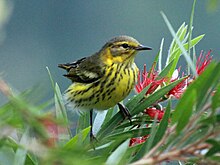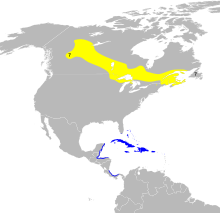Cape May warbler
| Cape May warbler | |
|---|---|
 |
|
| Male | |
 |
|
| Female | |
| Scientific classification | |
| Kingdom: | Animalia |
| Phylum: | Chordata |
| Class: | Aves |
| Order: | Passeriformes |
| Family: | Parulidae |
| Genus: | Setophaga |
| Species: | S. tigrina |
| Binomial name | |
|
Setophaga tigrina (Gmelin, 1789) |
|
 |
|
| Range of S. tigrina Breeding range Wintering range | |
| Synonyms | |
|
Dendroica tigrina |
|
Dendroica tigrina
The Cape May warbler (Setophaga tigrina) is a species of New World warbler. It breeds in northern North America. Its breeding range spans all but the westernmost parts of southern Canada, the Great Lakes region, and New England. It is migratory, wintering in the West Indies. This species is a very rare vagrant to western Europe, with two records in Britain as of October 2013. The English name refers to Cape May, New Jersey, where George Ord collected the specimen later described by Alexander Wilson. This species was not recorded again in Cape May for another 100 years, although it is now known as an uncommon migrant there.
The genus name Setophaga is from Ancient Greek ses, "moth", and phagos, "eating", and the specific tigrina' is Latin for "tiger-striped" from tigris, "tiger".
This bird is a small passerine and mid-sized New World warbler. Length can vary from 12 to 14 cm (4.7 to 5.5 in), wingspan is 19–22 cm (7.5–8.7 in), and body mass can range from 9 to 17.3 g (0.32 to 0.61 oz). Among standard measurements, the wing chord is 6.1 to 7.3 cm (2.4 to 2.9 in), the tail is 4.3 to 5 cm (1.7 to 2.0 in), the bill is 0.9 to 1.2 cm (0.35 to 0.47 in) and the tarsus is 1.7 to 1.9 cm (0.67 to 0.75 in). The summer male Cape May warbler has a brown back, yellowish rump and dark brown crown. The underparts are yellow, streaked black, giving rise to the bird's scientific name. The throat and nape are bright yellow and the face is striking chestnut with a black eyestripe. There is a narrow white wing bar.
Other plumages resemble washed-out versions of the alternate-plumaged male's, lacking the strong head pattern. The yellowish rump and at least indications of the white wing bar are always present.
...
Wikipedia

